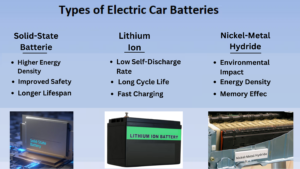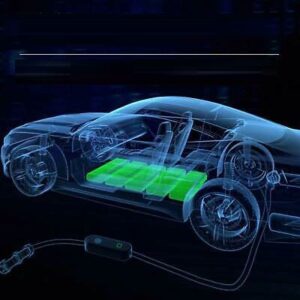Electric Car Batteries Explained Types, Benefits, and Challenges

What are Electric Car Batteries?
Electric car batteries, also known as electric vehicle (EV) batteries, are rechargeable batteries that provide the energy needed to power electric vehicles. Unlike internal combustion engine vehicles that rely on gasoline or diesel fuel, evs use electricity stored in batteries to operate their electric motors.
How electric car batteries work
- Basic components:
Electric car batteries typically consist of multiple cells grouped into modules, and these modules are assembled into a battery pack. Each cell contains two electrodes: an anode (negative) and a cathode (positive), separated by an electrolyte.
- Charging:
During charging, electrical energy is converted into chemical energy. The charger sends electricity to the battery pack, causing ions to move from the cathode to the anode through the electrolyte, storing energy in the battery.
- Discharging (powering the vehicle):
When the vehicle is in use, the stored chemical energy is converted back into electrical energy. Ions move from the anode to the cathode, creating a flow of electricity that powers the electric motor and other electrical systems in the vehicle.
- Battery management system (bms):
A crucial component of the battery pack, the bms monitors the battery’s state of charge, health, temperature, and voltage. It ensures safe and efficient operation, preventing overcharging, deep discharging, and overheating.
Types of Electric Car Batteries
- Lithium-Ion (Li-ion):
The most common type of battery used in evs today. Li-ion batteries are known for their high energy density, long cycle life, and relatively low weight.
- Nickel-Metal Hydride (NiMH):
Previously common in hybrid vehicles, NiMH batteries offer good performance but are heavier and less energy-dense compared to Li-ion batteries.
- Solid-State Batteries:
An emerging technology that promises higher energy density, faster charging times, and improved safety compared to traditional Li-ion batteries.

Benefits of Electric Car Batteries
- Environmental Impact:
Electric car batteries produce zero tailpipe emissions, reducing the overall carbon footprint of transportation. This is particularly beneficial in urban areas where air quality can be a significant issue.
- Cost Savings:
Although the initial purchase price of an EV can be higher, the cost per mile driven is generally lower due to the lower price of electricity compared to gasoline. Additionally, evs have fewer moving parts, leading to lower maintenance costs.
- Energy Efficiency:
Electric motors are more efficient than internal combustion engines, converting a higher percentage of the energy from the battery into vehicle movement.
- Energy Independence:
Using locally generated electricity for evs can reduce dependence on imported fuels and enhance energy security.
- Performance:
Electric vehicles offer instant torque and smooth acceleration, often resulting in better performance compared to traditional vehicles.
Challenges and Considerations
- Range Anxiety:
Concerns about the limited range of evs compared to traditional vehicles can be a barrier for some consumers. However, advances in battery technology are continually improving range.
- Charging Infrastructure:
The availability of charging stations can vary widely by region, affecting the convenience of using evs for long-distance travel.
- Battery Lifespan and Recycling:
While EV batteries have a long lifespan, they will eventually degrade and need to be replaced or recycled. Developing effective recycling processes is essential for sustainability.
- Initial Cost:
The cost of electric vehicles and their batteries can be higher than conventional vehicles, though prices are expected to decrease as technology advances and economies of scale are achieved.
Range Anxiety
- Definition:
Range anxiety refers to the concern that an electric vehicle (EV) will run out of battery power before reaching the destination or a charging station.
- Impact:
This anxiety can deter potential buyers from purchasing EVs, especially in regions with less developed charging infrastructure.
- Mitigation:
Improvements in battery technology are increasing the range of EVs, and the expansion of charging networks helps to alleviate these concerns. Additionally, advancements in fast-charging technology are reducing the time needed to recharge batteries.
Charging Infrastructure
- Availability:
The availability of charging stations varies widely, with some areas having a dense network of chargers and others having very few. This disparity can limit the practical usability of EVs, especially for long-distance travel.
- Types of Chargers:
There are different levels of charging, including Level 1 (standard household outlets), Level 2 (dedicated EV chargers), and Level 3 (fast chargers or DC fast chargers). The speed and convenience of charging depend on the type and availability of these chargers.
- Development Costs:
Building a comprehensive and accessible charging network requires significant investment, which can be a barrier to the widespread adoption of EVs. This includes not only the installation of chargers but also upgrading the electrical grid to handle increased demand.

Battery Lifespan and Degradation
- Longevity:
Like all batteries, EV batteries degrade over time, losing their ability to hold a full charge. Factors such as high temperatures, frequent fast charging, and deep discharging can accelerate degradation.
- Replacement Costs:
While EV batteries are designed to last for many years, they eventually need to be replaced, which can be expensive. This cost can be a concern for consumers, particularly when the vehicle is out of warranty.
- End-of-Life Management:
Proper disposal and recycling of EV batteries are critical to minimize environmental impact. Developing efficient and sustainable recycling processes is essential to reclaim valuable materials and reduce the need for mining new resources.
Initial Cost
- Purchase Price:
The upfront cost of electric vehicles is generally higher than that of internal combustion engine vehicles. This is primarily due to the cost of the battery pack, which is the most expensive component of an EV.
- Incentives and Subsidies:
Government incentives, such as tax credits, rebates, and grants, can help offset the higher initial cost of EVs. However, these incentives vary by region and may not be available indefinitely.
Battery Supply Chain and Raw Materials
- Critical Materials:
EV batteries require specific raw materials, such as lithium, cobalt, and nickel. The supply and extraction of these materials can pose ethical and environmental challenges, including concerns about human rights and environmental degradation.
- Supply Chain Risks:
The concentration of mining and processing activities in certain regions can lead to supply chain vulnerabilities, including geopolitical risks and price volatility.

Performance in Extreme Conditions
- Temperature Sensitivity:
Battery performance can be affected by extreme temperatures. Cold weather can reduce battery efficiency and range, while high temperatures can accelerate degradation.
- Thermal Management:
Advanced thermal management systems are used in EVs to maintain optimal battery temperature, enhancing performance and longevity. However, these systems add complexity and cost to the vehicle design.
Grid Impact and Energy Demand
- Increased Demand:
As the number of EVs grows, the demand for electricity will increase, potentially straining the electrical grid. This can be a concern, particularly in regions with limited generation capacity or outdated infrastructure.
- Peak Load Management:
Charging patterns can create peak load challenges for the grid, especially if many EVs are charged simultaneously during peak hours. Smart charging solutions and grid upgrades are needed to manage these challenges effectively.
Consumer Education and Perception
- Understanding of EV Technology:
Many consumers may not fully understand the differences between EVs and conventional vehicles, including aspects like charging, maintenance, and total cost of ownership.
- Misperceptions:
Common misconceptions, such as concerns about battery fires or the actual environmental impact of EVs, can influence consumer decisions. Public education and transparent information are crucial to address these concerns.
Regulatory and Policy Landscape
- Emissions Regulations:
Stricter emissions regulations and policies encouraging the adoption of EVs can influence market dynamics. However, these policies can vary widely between regions, affecting the consistency of market development.
- Support for Innovation:
Government support for research and development in battery technology, charging infrastructure, and recycling processes is essential for the continued advancement and adoption of EVs.




